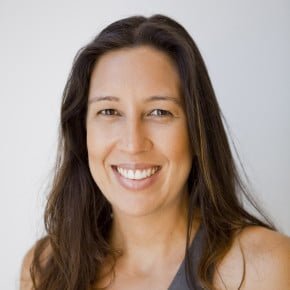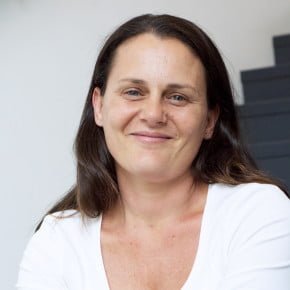Lee Hillam profiles BKA Architecture, a Sydney-based firm with an impressive approach to equitable employment, and explores the benefits of a flexible, part-time and gender-equitable workforce.

This Women in Architecture profile takes a different approach to the other articles in the series, which focus on individuals. Here we interviewed the directors of BKA Architecture, John Baker and John Kavanagh, plus the firm’s associates. Although the two directors at BKA are male, five of the seven associates and half of the whole practice are women. The five associates all have children (most of them quite young) and all but one work part-time. These are numbers not typical of our industry, and especially not in such senior positions.
After the large group interview, we spoke with a smaller group of female associates: Najla Khoury, Silvina Medel and Bruna Souto (two other associates, Allison Burrows and Tanya Awadallah, could not attend the meeting). Najla, Silvina and Bruna spoke of the challenges women in architecture face, and the enormous benefits that workplace flexibility can bring to both individuals and architectural practice.
We asked the directors and associates about BKA’s remarkable representation of women at the senior level. How did this come about? Have the directors employed heavy-handed positive discrimination to achieve this?
As it turned out, the directors were largely unaware that their practice looked different to others. Once it became clear that they were inadvertently leading the way, they looked more closely at the conditions that have made it so. John K said it comes from a long-standing practice of hiring students from UTS who had until recently completed their degrees under an apprenticeship model where they were employed in an office four days a week and attended university two nights and one full day. This set up a pattern of people working part time and being flexible to accommodate demands outside the office. So, when those students became graduates and stayed on at BKA, the part-time and flexible work pattern was already set. John K says, ‘I did it. I worked part time when my kids were young. So I know it can be done.’
It seems clear that these two men have directed their practice in a way that is blind to gender. When asked how they came to have so many women as associates, they say, ‘Well, it’s just merit-based. It’s not really deliberate.’
So, have there have been any issues from clients when they are presented with a part-time female project leader?
John Baker shrugs and looks to John Kavanagh, who also shrugs. No, seems to be the short answer. John B notes that really, all their clients care about is that the job is done well. Somewhere in the conversation it also becomes clear that they have a lot of long-standing clients and consultants. Whatever it is they’re doing, it’s working.
So, what are their tips for managing a flexible and part-time workforce?
- Try to arrange it so that employees have non-consecutive days off. If you work at BKA three days a week, Monday, Wednesday and Friday works best. That way, there’s never more than a day’s delay in responding to a client.
- Pair up staff so that someone working on the project is always in the office. Then, if the client desperately needs an answer to a question today, there is someone who knows the project.
- CC the directors on every email. That way, they will be up to speed on the project and be able to step in if no-one else is available.
When talking to the three women associates we start the conversation by quoting Melinda Dodson’s Women in Architecture profile in which she suggested that clients still underestimate women in architecture. Does this resonate with the women of BKA?
- Bruna Souto
- Silvina Medel
- Najla Khoury
It does. The clients underestimate them, and the consultants they work with tend to underestimate them, too. All this is met with patience.
Najla: They treat you as if you don’t know how to read their drawings, or don’t understand the concept of structural or stormwater drawings or whatever. But then, when you point out their mistakes, they can see, oh that’s right … Slowly they start to have equal respect for you as the architect.
Bruna: It’s important not to take it personally, that’s my attitude. I just trust my skills, and in two or three weeks the relationship starts to change.
Staff turnover at BKA is remarkably low. The associates we spoke to had been at BKA between nine and 16 years. Surely the availability of flexible and part-time work was a factor?
They all agree, though clearly they enjoy the work as well.
Bruna: Because that makes the whole work experience enjoyable.
Silvina: I didn’t think I’d be back after having my children and moving to Bangalow [in northern NSW], but slowly it’s grown and now we have a studio there.
Bruna: I was here before I became a mum, and once I was a mum I didn’t feel I wanted fewer opportunities because of that – and they didn’t treat me like that. It was the opposite.
The women associates are allocated projects as big or bigger than they feel they can handle, and are supported by the directors in those roles. In some ways, it seems the role of managing a project is well suited to part-time work. Directing others in the production of drawings and documents, managing consultants and liaising with clients are all tasks that can be tackled in smaller parcels of time, unlike the continuity of attention that is required for documenting a project, for example.
Bruna: It’s important to know that if you need to work three days you can, and you just go talk to the directors and it’s always OK, somehow.
The conversation then turns to working overtime and the expectation that everyone does what needs to be done to complete the job.
Though everyone at BKA does seem to work more hours than they’re strictly paid for, it is done with the understanding that there’s also significant flexibility to take off time when needed. If the associates are working from home because of a sick child, or come in late because of a dentist appointment, the directors do not question it. There is a genuine relationship of trust between the directors and the staff, and that trust is also felt by the clients, who see the directors backing their associate architects.
Najla: ‘They give full ownership and you feel the ownership. You are responsible for these projects.’
Bruna: If I have to take time off to go to an appointment I know how much overtime I’ve done, so I can do that. They would never say that you can’t take your child to the doctor or whatever.’
But surely it’s not all perfect? Where have the challenges been?
The group listed challenges such as rebuilding confidence after parental leave, managing school holidays and the cost of child care – all factors that relate to having children, and can impact on men and women in equal measure.
It seems that in the drive towards gender equity, an industry’s approach to accommodating the demands of parenting is always going to be a pivotal issue. It’s noteworthy that at BKA – where priority is given to the skill and talent of the architect, and gender and parental status are kept separate – it is possible and even advantageous to have a flexible, part-time and gender-equitable workforce.
Lee Hillam is the Chair of the National Committee for Gender Equity (NCGE) and a director of Sydney-based Dunn & Hillam Architects. She interviewed the directors and associates of BKA Architecture for the ‘Women in Architecture‘ series, co-published with the Australian Institute of Architects.























